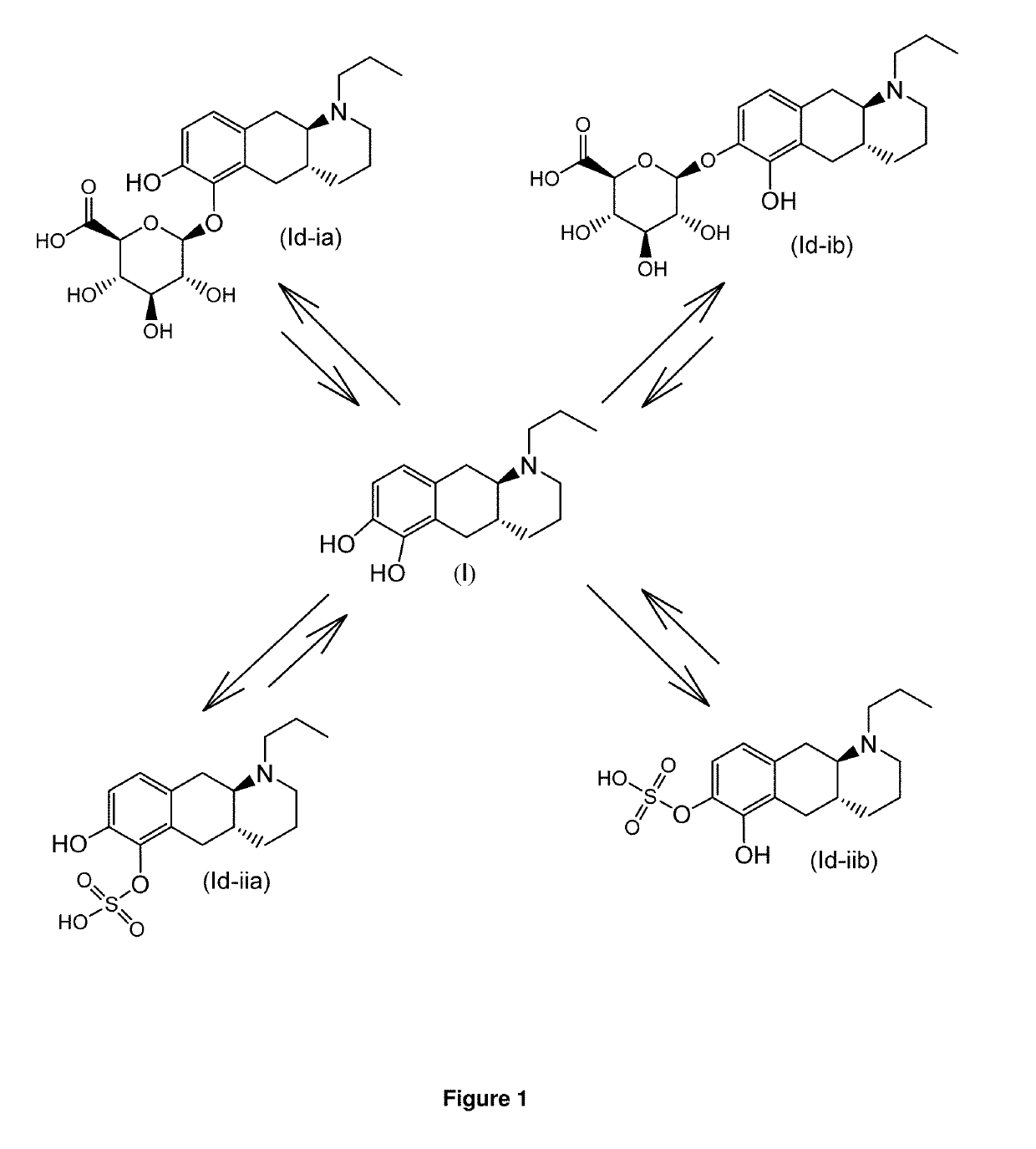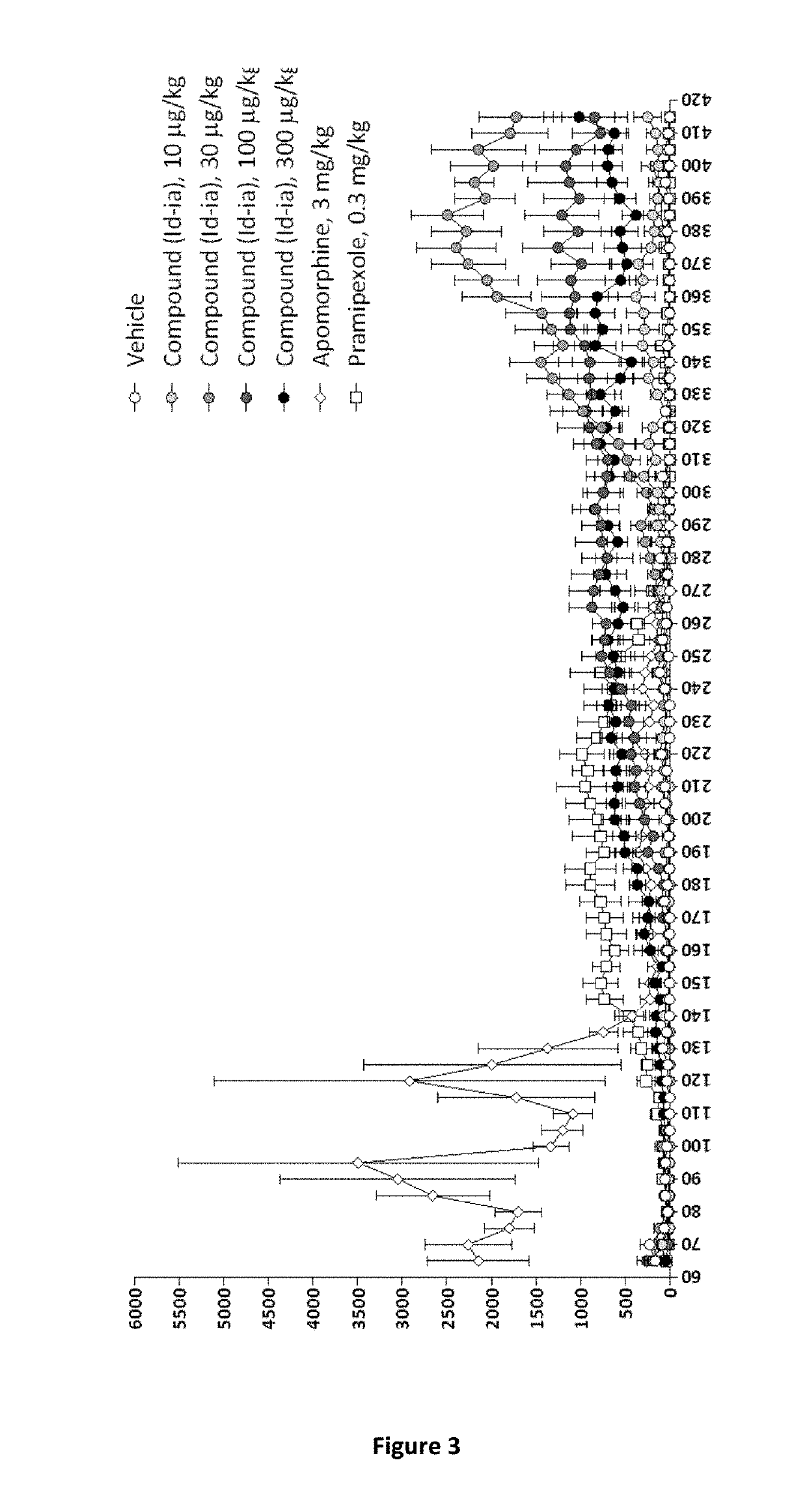Catecholamine prodrugs for use in the treatment of parkinson's disease
a technology of catecholamine and prodrug, which is applied in the field of catecholamine prodrug for use in the treatment of parkinson's disease, can solve the problems of poor pharmacokinetic profile, inability to predict the conversion to the parent compound in humans, and inability to achieve clinical use, so as to improve the minimal brain dysfunction (mbd), improve the effect of dopaminergic turnover and positive
- Summary
- Abstract
- Description
- Claims
- Application Information
AI Technical Summary
Benefits of technology
Problems solved by technology
Method used
Image
Examples
embodiment 1
E2. The compound or pharmaceutically acceptable salt thereof , wherein
R1 is H and R2 is selected from one of the substituents (i) and (ii); or
R1 is selected from one of the substituents (i) and (ii) and R2 is H; or
R1 and R2 are both represented by substituent (i); or
R1 and R2 are both represented by substituent (ii).
E3. The compound or pharmaceutically acceptable salt thereof according to embodiment 1, wherein R1 is H and R2 is substituent (i); or
R1 is substituent (i) and R2 is H; or
R1 and R2 are both represented by substituent (i).
E4. The compound according to embodiment 1, wherein said compound is the compound represented by formula (Id-ia) below
or a pharmaceutically acceptable salt thereof.
E5. The compound according to embodiment 1, wherein said compound is the compound represented by formula (Id-ib) below
or a pharmaceutically acceptable salt thereof.
E6. The compound according to embodiment 1, wherein said compound is the compound represented by formula (Id-iab) below
or a pharmac...
embodiment 17
E18. The compound or pharmaceutically acceptable salt thereof , which is a prodrug of the compound (4aR,10aR)-1-n-Propyl-1,2,3,4,4a,5,10,10a-octahydro-benzo[g]quinoline-6,7-diol (compound (I)), wherein said prodrug provides a PK profile wherein AUC0-∞ of (4aR,10aR)-1-n-Propyl-1,2,3,4,4a,5,10,10a-octahydro-benzo[g]quinoline-6,7-diol is more than 7000 pg*h / mL, such as more than 8000, such as more than 9000, such as more than 10000, such as more than 11000, such as more than 12000, such as more than 13000, such as more than 14000, such as more than 15000, such as more than 16000 pg*h / mL when said prodrug is administered orally to a Wistar rat in a dose corresponding to 287 mg / kg of (4aR,10aR)-1-n-Propyl-1,2,3,4,4a,5,10,10a-octahydro-benzo[g]quinoline-6,7-diol.
E19. The compound or pharmaceutically acceptable salt thereof according to any of embodiments 17-18, wherein said PK profile has been obtained by a PK experiment as described in Example 4 herein.
E20. The compound or pharmaceutical...
embodiment 25
E26. The compound or pharmaceutically acceptable salt for use as a medicament , wherein said medicament is an oral medicament such as a tablet or a capsule for oral administration.
E27. A pharmaceutical composition comprising a therapeutically effective amount of the compound or pharmaceutically acceptable salt thereof according to any of embodiments 1-23, and one or more pharmaceutically acceptable excipients.
PUM
| Property | Measurement | Unit |
|---|---|---|
| temperature | aaaaa | aaaaa |
| temperature | aaaaa | aaaaa |
| time | aaaaa | aaaaa |
Abstract
Description
Claims
Application Information
 Login to View More
Login to View More - R&D
- Intellectual Property
- Life Sciences
- Materials
- Tech Scout
- Unparalleled Data Quality
- Higher Quality Content
- 60% Fewer Hallucinations
Browse by: Latest US Patents, China's latest patents, Technical Efficacy Thesaurus, Application Domain, Technology Topic, Popular Technical Reports.
© 2025 PatSnap. All rights reserved.Legal|Privacy policy|Modern Slavery Act Transparency Statement|Sitemap|About US| Contact US: help@patsnap.com



